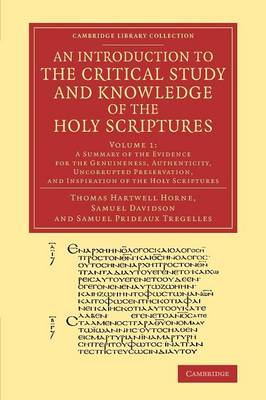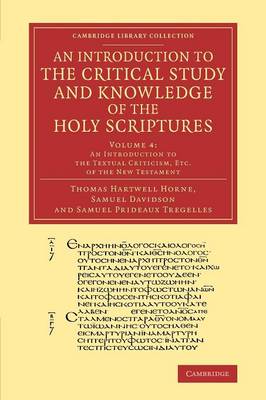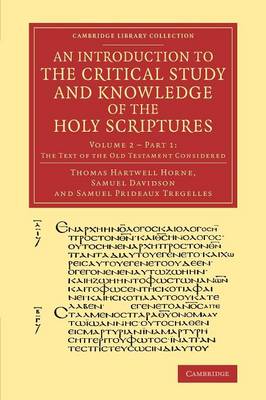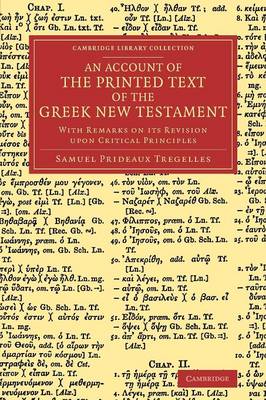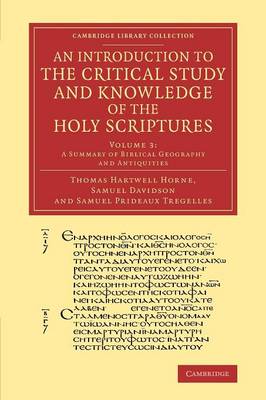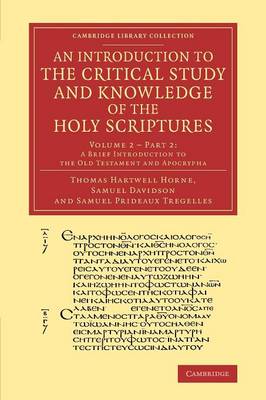Cambridge Library Collection - Religion
7 total works
An Introduction to the Critical Study and Knowledge of the Holy Scriptures: Volume 1, A Summary of the Evidence for the Genuineness, Authenticity, Uncorrupted Preservation, and Inspiration of the Holy Scriptures
by Thomas Hartwell Horne, Samuel Davidson, and Samuel Prideaux Tregelles
Published 21 November 2013
A painstaking compiler of catalogues and indexes, the biblical scholar and bibliographer Thomas Hartwell Horne (1780-1862) first published his most famous work in 1818, having begun his research for it many years earlier in 1801. Reissued here in five parts is the expanded four-volume tenth edition of 1856, which includes revisions by the scholars Samuel Davidson (c.1806-98) and Samuel Prideaux Tregelles (1813-75). A standard text in scriptural teaching for generations of Anglicans, this monumental and influential work of nineteenth-century biblical scholarship remains a valuable resource for modern researchers, reflecting the methods and perspectives of its era. Volume 1 addresses the authenticity and authority of the Old and New Testaments. Horne discusses the role of miracles and prophesy, and argues for the superiority of Christianity over other religions.
A painstaking compiler of catalogues and indexes, the biblical scholar and bibliographer Thomas Hartwell Horne (1780-1862) first published his most famous work in 1818, having begun his research for it many years earlier in 1801. Reissued here in five parts is the expanded four-volume tenth edition of 1856, which includes revisions by the scholars Samuel Davidson (c.1806-98) and Samuel Prideaux Tregelles (1813-75). This monumental and influential work of nineteenth-century biblical scholarship remains a valuable resource for modern researchers, reflecting the methods and perspectives of its era. Volume 4, rewritten by Tregelles for this edition, addresses textual criticism of the New Testament. Drawing strongly on his previous scholarship, Tregelles covers the history of the text, distinguished readings and important manuscripts, and he provides an introduction to each book of the New Testament.
A painstaking compiler of catalogues and indexes, the biblical scholar and bibliographer Thomas Hartwell Horne (1780-1862) first published his most famous work in 1818, having begun his research for it many years earlier in 1801. Reissued here is the expanded four-volume tenth edition of 1856, which includes revisions by the scholars Samuel Davidson (c.1806-98) and Samuel Prideaux Tregelles (1813-75). This monumental and influential work of nineteenth-century biblical scholarship remains a valuable resource for modern researchers. Volume 2, the work of Davidson, addresses the Old Testament and has been split into two parts for this reissue. Influenced by contemporary German scholarship, Davidson's contribution caused controversy, particularly around prophetic authorship and the role of divine inspiration, resulting in his resignation from Lancashire Independent College. Indeed, Horne distanced himself from this volume. Part 1 includes discussion of scriptural Hebrew, of Greek, Arabic, Latin and Syriac translations, and of textual history and interpretation.
An Account of the Printed Text of the Greek New Testament
by Samuel Prideaux Tregelles
Published 16 August 2011
A seminal figure in nineteenth-century biblical textual criticism, Samuel Prideaux Tregelles (1813-75) did much to formalise the emerging discipline. He published this account of his work on the Greek New Testament in 1854. Reflecting on previous editions of the New Testament, he gives a detailed account of its numerous versions since Erasmus and provides an excellent overview of biblical scholarship to that date. As well as discussing Tischendorf's pioneering work in using manuscripts previously neglected by Western scholarship, Tregelles reports the findings of other textual critics, such as Lachmann, Griesbach and Scrivener. He proceeds to describe his own critical methods and collations, bringing clarity to the developing field, and also presents notes on particular passages in the Gospels. This work still informs modern scholarship and serves to complement Tregelles's remarkable seven-volume Greek New Testament (also reissued in this series).
A painstaking compiler of catalogues and indexes, the biblical scholar and bibliographer Thomas Hartwell Horne (1780-1862) first published his most famous work in 1818, having begun his research for it many years earlier in 1801. Reissued here in five parts is the expanded four-volume tenth edition of 1856, which includes revisions by the scholars Samuel Davidson (c.1806-98) and Samuel Prideaux Tregelles (1813-75). This monumental and influential work of nineteenth-century biblical scholarship remains a valuable resource for modern researchers, reflecting the methods and perspectives of its era. Volume 3 contains a summary of biblical geography and antiquities, including the historical geography of the Holy Land, with discussion of its physical and agricultural features, as well as an account of the political and judicial systems of the Jews and Romans, a study of the existence and location of sacred artefacts, and a survey of Jewish customs mentioned in the scriptures.
A painstaking compiler of catalogues and indexes, the biblical scholar and bibliographer Thomas Hartwell Horne (1780-1862) first published his most famous work in 1818, having begun his research for it many years earlier in 1801. Reissued here is the expanded four-volume tenth edition of 1856, which includes revisions by the scholars Samuel Davidson (c.1806-98) and Samuel Prideaux Tregelles (1813-75). This monumental and influential work of nineteenth-century biblical scholarship remains a valuable resource for modern researchers. Volume 2, the work of Davidson, addresses the Old Testament and has been split into two parts for this reissue. Influenced by contemporary German scholarship, Davidson's contribution caused controversy, particularly around prophetic authorship and the role of divine inspiration, resulting in his resignation from Lancashire Independent College. Part 2, Davidson's exegetical 'Brief Introduction to the Old Testament and Apocrypha', includes extensive references to contemporary scholarship as well as research on sources and interpretation of meaning.
The Book of Revelation in Greek Edited from Ancient Authorities
by Samuel Prideaux Tregelles
Published 26 November 2009
Samuel Prideaux Tregelles (1813-1875) was a Cornish-born Biblical scholar who travelled to major libraries all over Europe to study ancient manuscripts with the aim of publishing a more reliable Greek New Testament than had been available to Luther, Tyndale and their successors. The 1844 edition of the Book of Revelation reissued here was his first major publication, and announced his larger project. It contains the Greek text, an English translation, and a meticulous critical apparatus which provides a window into nineteenth-century textual criticism, a burgeoning field in which scholars including Lachmann and Tischendorf were also active. Tregelles gives a detailed history of the printed editions of Revelation and shows how he went beyond the received text, examining more than forty thousand variants to establish the most authoritative version. Tregelles' criteria for evaluating the reliability of manuscripts, described in his Introduction, remain of interest to Biblical scholars today.
